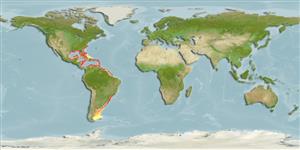Elasmobranchii (tubarões e raias) (sharks and rays) >
Squaliformes (Sleeper and dogfish sharks) >
Squalidae (Dogfish sharks)
Etymology: Squalus: Genus name from Latin 'squalus' meaning shark (Ref. 6885, 27436).
Environment: milieu / climate zone / depth range / distribution range
Ecologia
marinhas demersal; intervalo de profundidade 60 - 400 m (Ref. 247). Subtropical; 36°N - 56°S, 97°W - 45°W (Ref. 54893)
Western Atlantic: North Carolina to Florida (USA), Gulf of Mexico, Cuba, Hispaniola; southern Brazil and Argentina.
Tamanho / Peso / Idade
Maturity: Lm ? range ? - 50 cm
Max length : 110 cm TL macho/indeterminado; (Ref. 247); common length : 75.0 cm TL macho/indeterminado; (Ref. 247)
A slim, gray shark with tips of dorsal fins black and edges of pectoral, pelvic and caudal fins white; two dorsal fins each with strong, ungrooved spine at front edge (Ref. 26938).
Inhabits continental shelves and uppermost slopes. Found in 60 to 380 m deep (Ref. 26938). Found on or near the bottom in large, dense schools. Probably feeds on bottom fishes and invertebrates. Ovoviviparous, with about 10 young per litter. A huge parasite (isopod) lives in its buccal cavity. Seldom used for food, but taken in commercial catches for its liver which yields oil and vitamins. Maximum depth reported taken from Ref. 55584.
Ciclo de vida ou comportamento de acasalamento
Maturities | Reprodução | Spawnings | Egg(s) | Fecundities | Larvas
Ovoviviparous, with about 10 young per litter (Ref. 247). Distinct pairing with embrace (Ref. 205).
Compagno, L.J.V., 1984. FAO Species Catalogue. Vol. 4. Sharks of the world. An annotated and illustrated catalogue of shark species known to date. Part 1 - Hexanchiformes to Lamniformes. FAO Fish. Synop. 125(4/1):1-249. Rome, FAO. (Ref. 247)
Status na Lista Vermelha da UICN (Ref. 130435)
Ameaça para os humanos
Harmless
Uso pelos humanos
Pescarias: pouco comercial
Ferramentas
Relatórios especiais
Baixar XML
Fontes da internet
Estimates based on models
Preferred temperature (Ref.
123201): 13.6 - 23.7, mean 18.7 °C (based on 111 cells).
Índice de diversidade filogenética (Ref.
82804): PD
50 = 0.5000 [Uniqueness, from 0.5 = low to 2.0 = high].
Bayesian length-weight: a=0.00339 (0.00162 - 0.00707), b=3.10 (2.93 - 3.27), in cm total length, based on LWR estimates for this Genus-body shape (Ref.
93245).
Nível Trófico (Ref.
69278): 4.2 ±0.6 se; based on diet studies.
Resiliência (Ref.
120179): Muito baixo(a), tempo mínimo de duplicação da população maior que 14 anos (Fec=10).
Fishing Vulnerability (Ref.
59153): High to very high vulnerability (66 of 100).
